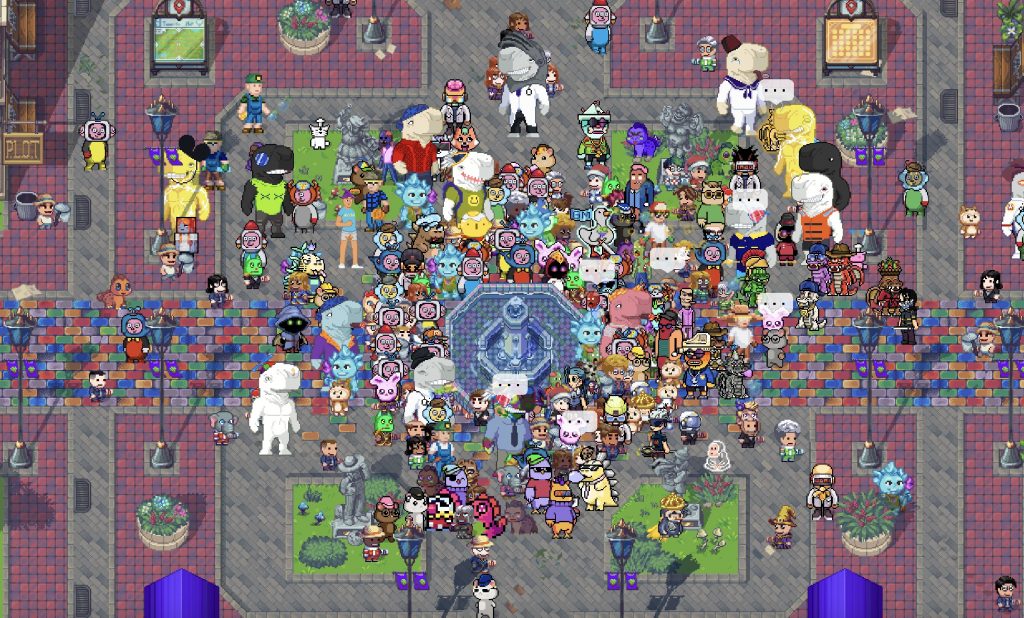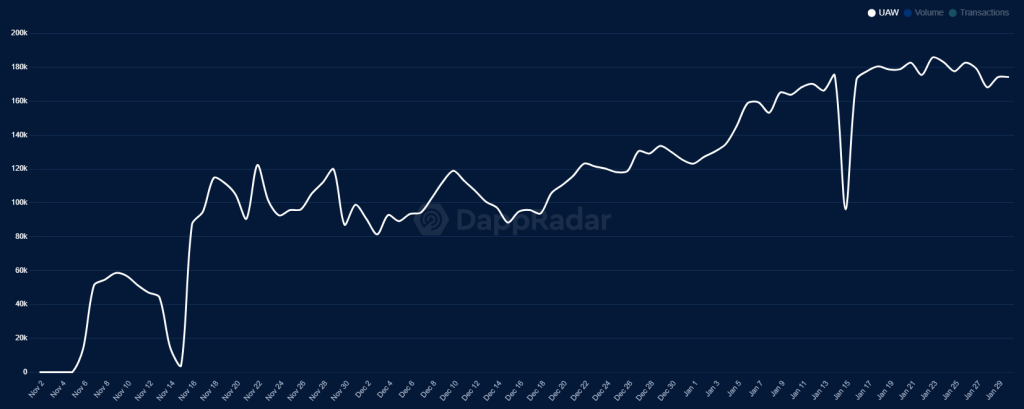Luke Barwikowski on the from-the-ground-up rise of Pixels

In the latest episode of his Blockchain Gaming World podcast, editor-in-chief Jon Jordan talks to Pixels’ CEO Luke Barwikowski about his background prior to Pixels, the decision to move to Ronin, and how he’s dealing with the game’s initial success – notably in terms of ensuring its long-term sustainability.
This interview has been edited for length and clarity.
You can also listen to the podcast via the Fountain app and earn Bitcoin.
BlockchainGamer.biz: Can you give us some background on how you got into the sector?
Luke Barwikoswki: On a personal level, it started when I was 12 years old. I started coding when I was 12. I started making video games when I was 12. I just fell in love with game development from a really young age. What’s funny is I had early exposure to Bitcoin as well. I started mining Bitcoin when I was 13 or 14 in my parents’ basement. I thought it was the coolest thing that I could just leave my parents’ computer on. I think Bitcoin was like $13 when I started mining it. I don’t have any of that Bitcoin now. I’m not a Bitcoin millionaire. But I got really early exposure to crypto.
The interesting thing is when I studied computer science and economics at university, my professors hated Bitcoin. For a while, even through the 2017 bull cycle, I tuned out from crypto. I was skeptical of the value behind it. Instead I started a different entrepreneurial journey. I worked in Silicon Valley for almost two years. I left my job and I started doing some freelance work and I started my own companies too.
For two years before we started Pixels, I was in the virtual events space, kind of like the metaverse before it was labelled metaverse. This was in 2019, 2020. We learned a ton of lessons in that we had a really interesting product. It was the first application of what you call spatial video chat. But we had no predictable usage. We were selling to enterprise companies, companies like Apple and Uber were customers. But the issue was we never knew when their next event was going to be. And if we did have consistent use cases, the best scenario was people were using our spaces for about an hour a week on a scheduled cadence.
This was in 2021 when we realized it just was not working. We needed to try something else and that was at the same time as Axie Infinity’s rise to prominence. That was the first time where it clicked in my head that there’s something really interesting with this application of cryptocurrency and this application of the blockchain. With my economics background, I was just fascinated by the idea of building an economy ground-up. There was tons of interest on my end.
At the same time, there was an NFT collection using our product. They kept bugging us to support their NFTs. Eventually they bugged us enough where I caved in because we were in a pivot mode, trying to figure out what to do with this tech. And it created this really interesting use case. We were one of the first products to allow people to use NFTs as avatars and that got us a lot of attention in web3. Combined with what I was seeing with Axie Infinity, it gave me really strong conviction to move in that direction. We started building in September 2021. We launched our own NFT collection. And we’ve been building Pixels since then.
What’s that building process been like?
It’s nuts. It’s very unpredictable. It’s not easy. The ethos of Pixels is building with community first. We take a really different approach to building than traditional game studios. We’ve been building in public for two years. I’ve been hopping on AMAs with our community, giving complete transparency into what our objectives are, what we’re trying to build, who we are. The whole point of what we were trying to focus on in web3 was finding an audience who cared about what we were building, and building with them. This building in public approach set the entire intention and path of Pixels. That’s been a large part of why we’re here now.
Because before we moved to Ronin, we had a community who actually liked the game. We got feedback, we built it iteratively. And once we moved to Ronin, that was the big difference maker for us, where we had a good product with a decent level of baseline retention. And then Ronin brought this crazy level of distribution. So those two things together have been the difference maker and led to where we’re at now.
Were you a big gamer growing up?
I grew up playing RuneScape, like I grew up playing RuneScape. I can’t emphasize how much I played growing up. It was a really big part of my childhood, a really big part of my upbringing. That’s where so many of my friends and I socialized, hung out after school, things like that. MMOs are deep in my veins for that reason. And that’s part of the interesting part of web3 gaming to me, open economy, all the economics around it.
When we first moved onto Pixels it was like, what if we had RuneScape onchain and what if we had RuneScape as this open economy combined with the cryptocurrency? There’s a lot of inspiration that we’re taking from those MMOs in terms of how we build Pixels, how we think about economics, how we think about the different player personas.
How has the vision for Pixels changed since 2021?
There’s so many things we made assumptions about in web3, especially early on, that we have completely flipped on. I think that’s part of our advantage in Pixels, of building more like a startup and iterating. I still think that nobody really knows what’s going to work in web3 gaming, including us. Having that mindset rather than us claiming we have this master plan and we are 100% sure it’s going to work in web3, we like to take more of an exploratory approach, more like a lean startup where we’re on our way to find product market fit.

It’s a combination of our best intuition and also thinking about what the market actually responds to well, what our players like, what works in practice, what I’ve learned about web3 tokenomics, game design. You need to be willing to adjust and iterate. You need to be willing to explore things that you didn’t explore before in order to find out what works.
There’s this theoretical side to how games might work and that’s great. You can do all the planning that you want, but I think Mike Tyson said it best. Everybody’s got to plan until they get punched in the face. You can’t plan for some of the other problems that you’re gonna be experiencing in web3. On a side note, that has been a really awesome part of working with Axie Infinity, working with the Sky Mavis team, because they’re giving us so much guidance on all the things that they ran into before. That’s been a huge advantage for us because we don’t have to fall into the same mistakes they made.
Can you talk about the decision to move from Polygon to Ronin?
I’m not here to talk bad about anybody or say one blockchain is better than the other, but I can say the value that Ronin’s brought and what we were looking for when we were thinking about moving chains. For me, the biggest part and the hardest part of web3 is distribution and user acquisition.
In web3, you don’t have access to additional UA platforms or traditional distribution platforms like Steam or the App Store, and that is really hard for a web3 game. There is a whole host of things where maybe that’s gonna get figured out in the long run, but me as a founder, I’m not waiting on other people to figure out these problems. I’m not waiting years and years to figure out how we can get this solution.
I’ve always felt that the space should work as the relationship between chain and game, should be more like publisher to game. And Ronin, they got that. We have so many shared values in our ethos of how we build, how we view the space. It just made natural sense for us to move there.
I’ve been talking to every chain and a lot of other interesting chains are doing some interesting stuff. But for us, the things that we were looking at was mentorship from people who had been there and done that. I was so sick of getting advice in web3 gaming from people who had not shipped a web3 game. They just didn’t understand the nuance, the depth, all the issues that you might run into.
You just have to be in web3 to understand the problems that come with it. And Ronin, Axie Infinity, Sky Mavis, they’re the only team in web3 that actually achieved scale in web3 gaming before. They’re the people who have the most knowledge on how to mitigate some of the issues, how to build out better systems and go in that direction. So the mentorship, the advice, the ability to work closely with them was a huge draw to us.
And the other aspect was the distribution layer. Again, you don’t have distribution access like you do in web2 in web3 and the distribution that Ronin brings is insane. I think everybody sees it now that we’ve launched on the Ronin network, what the Ronin effect can actually do, how many users Ronin’s already onboarded. On other chains, you might have some activity, but they’re not gamers. And that’s the important part for a web3 game, right? You want gamers playing your game. You don’t want DeFi traders or all of these other types of personas that exist in web3 in your game. You want people who are actually playing the game, they’re going to enjoy it and Ronin has already done the hard work of onboarding millions of users onto their chain and it was a natural move for us for that reason.
What did you expect the launch on Ronin to be like?
So Axie Infinity was sitting at 30,000 DAUs at the time. I was like, if we hit 30,000 DAUs when we launch on Ronin, it’s a massive success. We were sitting at 5-10,000 DAUs on Polygon before. The result completely exceeded my expectations.
It was a bit of a risk we were taking but I had this feeling there were a ton of users that were waiting on the Ronin for more experiences and more games and they could be reactivated. That’s what we proved. They were in the ecosystem, they had a stake in the ecosystem and they had the willingness to play more games. But it was a bit of a risk. Before we moved to Ronin, I was telling people that we were going to be doing it and I got a lot of question marks. But the week after we did it, nobody questioned it anymore.
What was it like handling that increase in player numbers?
Luckily the team is already somewhat experienced with liveops. The difference of liveops between 10,000 DAUs and 150,000 DAUs is quite different, obviously. Infrastructure started breaking. We had to talk to all of our enterprise vendors and sign new contracts. So yeah, growing pains for sure.
But I feel we’re in a really lucky spot. We’re a bit more capitalized and we can start to invest, more resources in the liveops and content and also more resources into innovation, new features, all the things we want to be building out when it comes to the roadmap.
Community management too. That’s a huge one. The community management of 10,000 to 20,000 users is a lot different than the community management of 100,000. We’re having to find ways to scale that in different areas. For example, I was extremely hands-on with community management early on. For the first two years of Pixels, I was the most active person in our Discord. And unfortunately, I don’t have the same amount of time as I did before. What we’ve done a really good job at is scaling different types of people into our ecosystem, having more community ambassadors. Heidi on my team is one of the ones leading that. She’s super smart with that side of things. Now I feel like we’re in a better spot where we can start to focus on the new stuff and roll that out over the next like, three to 12 months. And that’s exciting too, because we had a lot of stuff planned.
The play-to-airdrop campaign worked really well too.
Yeah, it got us from 110,000 daily actives to over 170,000 daily active wallets. What we want is to find the best users inside of our ecosystem and we want to reward them. We want to give them great incentives to stay inside of the ecosystem.

It’s interesting because it’s become a whole new meta in web3 gaming, and it’s something we were experimenting with for the BERRY token over a year ago. I want to say we were the ones who coined that term even. But it’s super exciting to see it come back in terms of this meta. The PIXEL token is quite near and that’s the next big thing for us. That’s what we’re most excited about.
What’s happening next?
We’re releasing the PIXEL token, which is a huge thing to be doing. We’re really, really excited about what this unlocks for us. It’s how we start to shift the economics to be more sustainable than they are right now. We’re also really excited to get out rewards that are more predictable so we can much more easily distribute them in a precise manner.
One of the hard questions in web3 is how do you identify the best users? How do you reward the best users? And how do you actually get them the earnings? It’s interesting because play-to-earn is a dirty word in web3 right now. But I think there’s a version of it that’s going to be successful in the future of gaming.
We’ve introduced some systems like a reputation system, which has been quite effective. Basically we look at some off-chain data, some on-chain data, if you played other web3 games, if you have socials connected, that increases your reputation score. But we also combine this with in-game data – have you been progressing through the game? Do you trade with bot-like players, things like that?
And then we can get a better idea of who the users are who are helping us and helping create growth in the ecosystem. That’s what we want to be focusing on when we think about the PIXEL token. We have this idea that there are four user personas.
- There’s the free-to-play players,
- There’s VIP players,
- There’s landowners, and
- there’s what we call ambassadors, people who are creating content, who are sharing, referring.
And over the next six months, we want to get even more granular into all of these personas.
There’s going to be a huge focus on gameplay over the next six months as well. We have a couple of big releases that we’ve been working on and a couple of awesome features that I’m excited about. The first being Chapter 2, which is basically a rework of a lot of the core systems inside of Pixels. It’s going to change the gameplay pretty drastically.
And that’s one thing that we’re not afraid to do. If we see something that’s not working, I’m willing to rip up everything and try something else. We’re not afraid of that because we know it’s better in the long run if we make some short term painful decisions. It might affect growth a little bit in the short run, but what we are really working for is long term sustainability in all of our economics and the gameplay. We want to make sure that people are playing this because they’re having fun and then having the incentives to be something on top.
We have guilds, that’s a new social-fi feature we’re going to be releasing. It’s kind of like if friend.tech merged with gameplay and guilds. It’s going to be tightly integrated into our Chapter 2 release as well. We want to shift a lot of the play style from just grinding. There’s a user persona that loves to grind, but it’s not the best gameplay for all personas so we want to start implementing more social dynamics, more social play.
And one new interesting concept we want to start to introduce is the idea of winners and losers. A game is fun when there’s stakes, when you don’t know you’re going to have guaranteed success. We want some elements of risk, more like a traditional MMO in that sense. That’s where some of the RuneScape inspiration comes. We take a lot of inspiration from EVE Online when we’re thinking about some of the future economics too. I think that’s a great example of a web2 game that’s shockingly like web3.
Find out more about Pixels via its website.

Comments are closed.